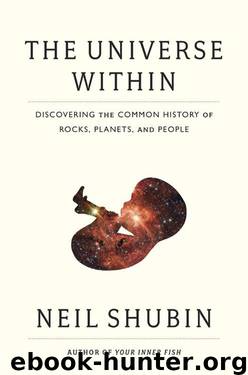The Universe Within by Neil Shubin

Author:Neil Shubin [Shubin, Neil]
Language: eng
Format: epub
Tags: Science, Life Sciences, Human Anatomy & Physiology, Anatomy & Physiology, Evolution
ISBN: 9780307907868
Google: JR44Rn8Sn_oC
Amazon: B008LMD8PI
Publisher: Pantheon
Published: 2013-01-08T00:00:00+00:00
This was an age of exploration of the natural world, and by looking at rocks and fossils, people began to formulate new ideas. Ships returned monthly from the far corners of the planet loaded with minerals, plants, animals, and rocks previously unknown to science. Natural philosophers of all stripes—people we would today call anatomists, paleontologists, and geologists—were in the center of the action, attempting to decipher the menagerie of biological curiosities that were being brought home.
One of the luminaries of this period, Georges Léopold Chrétien Frédéric Dagobert Cuvier, had an ego as large as his name. Born to humble origins, he died Baron Cuvier, one of the leaders of the Natural History Museum in Paris.
One expedition returned to Paris from South America with a giant six-foot-long skeleton shaped something like a small troop transport. With massive bones, large claws, and a skull with flattened teeth, this creature departed from anything in Cuvier’s experience until he looked closely at the vertebrae and limb bones. Being an astute anatomist, he saw that nestled inside this bizarre skeleton is the body plan of a sloth. But it was unlike any alive today.
Then several different kinds of elephant-like bones were brought to Cuvier’s attention. Seeing the differences from elephants, he identified the bones as reflecting a new species: mammoths. But these discoveries, satisfying as they were for understanding the diversity of life, raised a troubling question: Where on Earth were these creatures still alive?
Cuvier made the connection: perhaps the large sloths and mammoths were no longer roaming the planet but instead revealed lost worlds of creatures. The concept of extinction, something so fundamental to the way we see the world today and alien to many thinkers for millennia, now explained the goings-on inside the rocks.
One example after another of long-lost life appeared. Spelunkers in Germany ran across the large bones of a monster or dragon lying on a cave floor. An anatomist from the local medical school saw that they were from some sort of bear, but one so large and oddly proportioned that it was unlike anything walking Europe. Years later, Thomas Jefferson found giant mammoths, sloths, and other creatures near his home in Virginia.
Cuvier was a big thinker, and not satisfied with mere description, he drew generalizations from his observations, putting his theories on the line. To Cuvier, the conclusion was obvious: extinction was not only real but common. So prevalent and important was this concept that in an early monograph he declared, “All of these facts … seem to me to prove the existence of a world previous to ours, destroyed by some kind of catastrophe.”
Cuvier’s idea, like that of Phillips before him, was that catastrophes shaped Earth. This idea was the cutting-edge science of its day, having the weight of evidence and the stamp of eminent authority. It also was virtually ignored by scientists for over a hundred years.
The notion of catastrophes lay in direct conflict with the reigning scientific approach of the day. This alternate notion was so powerful in explaining Earth that it did not allow interlopers.
Download
This site does not store any files on its server. We only index and link to content provided by other sites. Please contact the content providers to delete copyright contents if any and email us, we'll remove relevant links or contents immediately.
The Lonely City by Olivia Laing(4134)
Animal Frequency by Melissa Alvarez(3764)
All Creatures Great and Small by James Herriot(3531)
Walking by Henry David Thoreau(3242)
Exit West by Mohsin Hamid(3203)
Origin Story: A Big History of Everything by David Christian(3147)
COSMOS by Carl Sagan(2964)
How to Read Water: Clues and Patterns from Puddles to the Sea (Natural Navigation) by Tristan Gooley(2889)
Hedgerow by John Wright(2784)
The Inner Life of Animals by Peter Wohlleben(2779)
Origin Story by David Christian(2696)
How to Read Nature by Tristan Gooley(2672)
Project Animal Farm: An Accidental Journey into the Secret World of Farming and the Truth About Our Food by Sonia Faruqi(2668)
How to Do Nothing by Jenny Odell(2653)
Water by Ian Miller(2601)
A Forest Journey by John Perlin(2592)
The Plant Messiah by Carlos Magdalena(2460)
A Wilder Time by William E. Glassley(2369)
Forests: A Very Short Introduction by Jaboury Ghazoul(2341)
